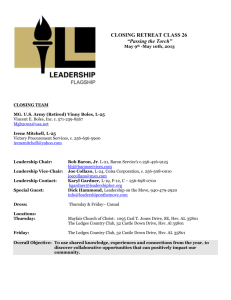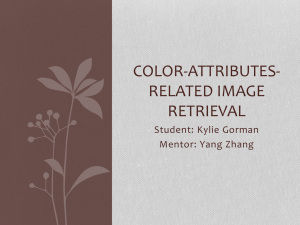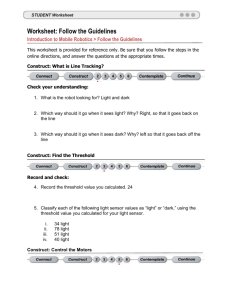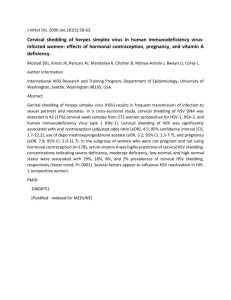Document 13134258
advertisement
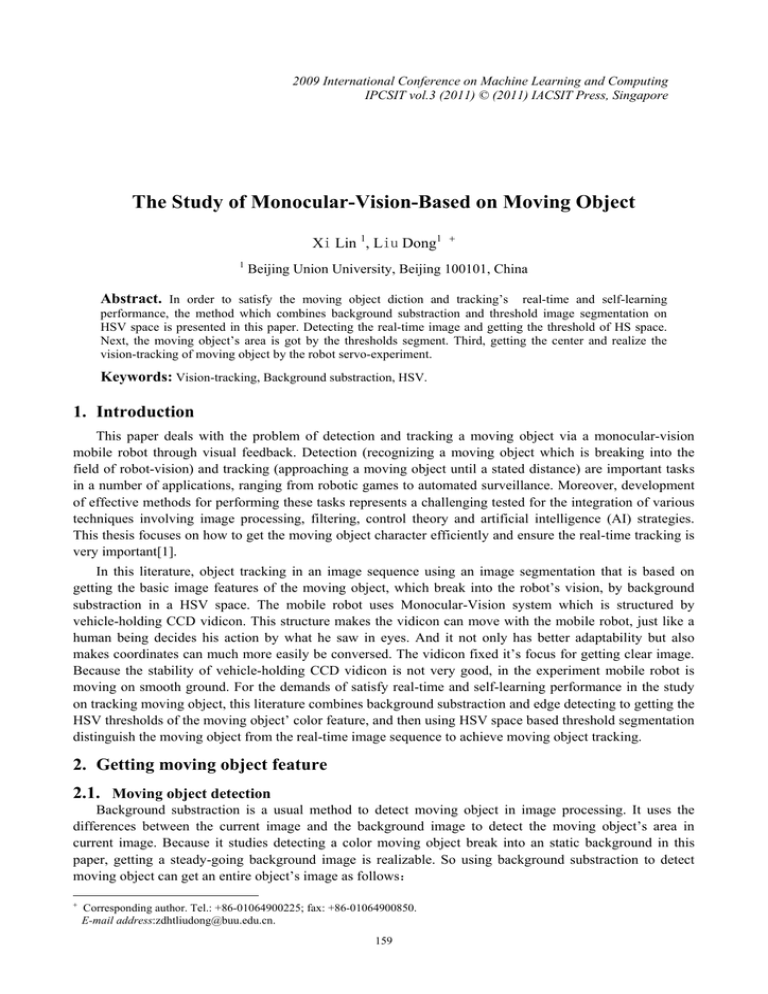
2009 International Conference on Machine Learning and Computing
IPCSIT vol.3 (2011) © (2011) IACSIT Press, Singapore
The Study of Monocular-Vision-Based on Moving Object
Xi Lin 1, Liu Dong1
1
Beijing Union University, Beijing 100101, China
Abstract. In order to satisfy the moving object diction and tracking’s real-time and self-learning
performance, the method which combines background substraction and threshold image segmentation on
HSV space is presented in this paper. Detecting the real-time image and getting the threshold of HS space.
Next, the moving object’s area is got by the thresholds segment. Third, getting the center and realize the
vision-tracking of moving object by the robot servo-experiment.
Keywords: Vision-tracking, Background substraction, HSV.
1. Introduction
This paper deals with the problem of detection and tracking a moving object via a monocular-vision
mobile robot through visual feedback. Detection (recognizing a moving object which is breaking into the
field of robot-vision) and tracking (approaching a moving object until a stated distance) are important tasks
in a number of applications, ranging from robotic games to automated surveillance. Moreover, development
of effective methods for performing these tasks represents a challenging tested for the integration of various
techniques involving image processing, filtering, control theory and artificial intelligence (AI) strategies.
This thesis focuses on how to get the moving object character efficiently and ensure the real-time tracking is
very important[1].
In this literature, object tracking in an image sequence using an image segmentation that is based on
getting the basic image features of the moving object, which break into the robot’s vision, by background
substraction in a HSV space. The mobile robot uses Monocular-Vision system which is structured by
vehicle-holding CCD vidicon. This structure makes the vidicon can move with the mobile robot, just like a
human being decides his action by what he saw in eyes. And it not only has better adaptability but also
makes coordinates can much more easily be conversed. The vidicon fixed it’s focus for getting clear image.
Because the stability of vehicle-holding CCD vidicon is not very good, in the experiment mobile robot is
moving on smooth ground. For the demands of satisfy real-time and self-learning performance in the study
on tracking moving object, this literature combines background substraction and edge detecting to getting the
HSV thresholds of the moving object’ color feature, and then using HSV space based threshold segmentation
distinguish the moving object from the real-time image sequence to achieve moving object tracking.
2. Getting moving object feature
2.1. Moving object detection
Background substraction is a usual method to detect moving object in image processing. It uses the
differences between the current image and the background image to detect the moving object’s area in
current image. Because it studies detecting a color moving object break into an static background in this
paper, getting a steady-going background image is realizable. So using background substraction to detect
moving object can get an entire object’s image as follows:
Corresponding author. Tel.: +86-01064900225; fax: +86-01064900850.
E-mail address:zdhtliudong@buu.edu.cn.
159
Firstly, a background image should be stored which captured by vidicon. And a background image
statistical model B(x,y) will be founded by every pixel in the image. Secondly, the current k-th frame image
fk(x,y) subtracts the background image B(x,y),and computing the pixel of fk(x,y) which departure the value
of B(x,y) more than the threshold T. And these pixels are judged in the moving object, as follow formula:
1, f (x, y) Bk1 (x, y) T
Dk (x, y) k
0, others
T is grey threshold value. The detected area of object are composed by the pixels of fk(x,y) which
computing values of D equal 1.
Background substraction can efficiently detect if there is a moving object in current image frame, but
can not identify if the moving object is enter the image entirely. So this arithmetic is improved by combining
with an object location identify method in this paper. On the assumption, current image frame( fk(x,y) )
object includes N points which recorded as Pi={ (xi,yi)|i=0,1,2,3,…,N-1}.If it doesn’t exist a point
Pi={( xi,yi)|(xi =0∪yi =0)∪(xi =320∪yi =240)), i=0,1,2,3,…,N-1}, it judges that the object
was enter the image entirely in the k-th image frame, and the object area we got in this image were integrated.
The experiment proved that the background substraction combines with object location identify method
can avoid losing information , for not gathering moving object as information of moving object while the
object enter the image entirely.
2.2. Getting moving object’s HSV threshold values
When the object area is certain, this area which is RGB image should be converted to HSV form and get
the HSV threshold values. This is because the robot uses RGB-color-based vision system in this study. But
some factors, which brought by vidicon like high-lightness, shadow and as so on, will affect image
processing crucially. The RGB color space is not efficient in describing objects’ color and dealing with
calculation. So this literature uses another color space – HSV to process the color image. HSV model is
much more like what human apperceived of color. Its hue attribute can reflect the color category exactly and
be less affected by the environment’s illumination and has stable and narrow values range, so can make it to
be one of the primary parameters. Compared with RGB model HSV model can be the basis of detection
better[3-4]. This paper uses HS model, which predigests from HSV system, to get the object color feature
threshold values. Because it can certain the object’s color attribute and independent from lightness
information. Comparing with HSV model, it is not only reduce the calculation but also assure the veracity,
advancing the capability of real-time image processing. The formula that convert RGB model to HS model is
as follows:
H0=0
G0=G-B
R0=R-B
H=H0+120G/(G0+R0)
S=(max+min)/min
The max and min are the max and min of original RGB image’s three components’ R;G;B, then obtain
the histogram of the moving object and certain the HSV image’s thresholds Hmin;Hmax;Smin.
3. HSV-threshed-based segment of moving object tracking
Manuscript is accepted for review with the understanding that no substantial portion of the paper has
been published or is under consideration for publication elsewhere and that its submission for publication has
been approved by all of the authors and by the institution where the work was carried out. It is further
understood that any person cited as a source of personal communications has approved such citation. Articles
and any other material published in the proceeding represent the opinions of the authors and should not be
construed to reflect the opinions of the Editor(s) or the Publisher.
160
Firstly,the RGB images real-time gathered by image grabing card should be converted to HSV images.
Then the image compare with HSV model’s threshold values. The pixels are moving object’s, when the
comparisons satisfy follow conditions:
Hmin<H<Hmax
Smin<S<1
Then the background can be segmented from the image, and getting the moving object.
After HSV threshold segment, the color image is converted into two valued image. Then the object’s
contour is got by borderline tracking arithmetic. On the assumption, the borderline includes M points in the
image, recorded as Si={ (xi,yi)|i=0,1,2,3,…,M-1}. The (xi,yi) is the i-th point’s coordinates. And
the centroid of the object’s area is defined as Pc=(Xc,Yc), as follows are the formulas to get centroid:
1
X c N
P c ( X c, Y c )
Y 1
c
N
N 1
i 0
xi
N 1
i 0
yi
The experiment proved that the HSV-threshold-based image segment can get robust segment results
during different illumination conditions when light intensity is not varies greatly, And the result is
good ,even the object is colorized, nonsolid color or parts of the object is kept out. So this method, using
HSV-threshold-based image segment to get the object’s borderline, can get good result in this paper.
4. Experiment and simulation
Before the tracking begins, a digital RGB image should be received firstly as the background image from
image grabing card. When moving object moves into the CCD vidicon’s visual field, an area of the object
will be parted from the real-time image with background substraction. If the object area pass the object area
detection, this area will be converted into HSV form, and a HS histogram will be built. The H and S’s
thresholds of the moving object can obtain from the histogram. This processing corresponds to a selflearning course. During the following tracking course, the thresholds’ standard will not change until a next
new tracking causing a new learning. Then begin track. Comparing the real-time image, which is captured by
image grabing card, with obtained H and S’s threshold values, a centroid of the moving object that is parted
from background will obtain (Fig. 1). Figure 1(a) is background image. Figure 1(b) is real-time image.
Figure 1(c) is the result getting through background substraction, and it is judged that the object does not
enter the visual field entirely by object area detection. So next image frame (Fig. 1 (d)) is took. Figure 1(d)
pass the detection, then obtain it’s HS threshold values. Figure 1(e) is a two valued image converted from
Figure 1(d). Figure 1(f) is the centroid.
The size of tracking interface is 320×240 pixels. In this experiment, the relation between the moving
object’s centroid (the moving object’s ubiety relate to the robot) and robot’s rate and angle’s should be
obtained in advanced by existing knowledge and experiences. Figure 2 is the object tracking image. The dots
of the picture are the object’s centroids moving track. It was based on the detected moving object’s centroids
in every image frame of the image sequence. It can be seen that most of the dots distributed in this area of
tracking interface: X-coordinate (80~240) and Y-coordinate (60~180), excepting the rate of moving object
change intensely.
This experiment proved that the proposed method in this paper can efficiently track the solid color or
nonsolid color object’s motion. It can be seen that this method can make robot taking a quite stable tracking
result in short time, for most of the moving object’s centroids are in the middle part of the visual image.
161
Fig. 1: A centroid of the moving object.
Fig. 2: The object tracking image.
Conclusions:
In this literature, the method combines background sunstraction and moving object detection are to
tracking the moving object which breaks into the robot’s visual field, and self-learning the color feature of
object. The experiment not only shows that the method can obtain the feature information of object
completely, but also embodies the Self-adaptive and self-learning properties of mobile robot during the
object motion tracking. And using the HSV-space-based HS threshold values as the object feature can reduce
the affection from some factors like: light, shadow, nonsolid color and so on. This method efficiently realizes
moving color-object tracking.
5. References
[1] SHAO Wen Kun, HUANG Ai Min, Wei Qing. Review of Object Tracking Method[J]. Image Technology, 2006, 1:
17-20, 2.
[2]
J. Gonzales, and so on. Digital Image Processing[M]. Ruan Qiuqi, Ruan Yuzhi, Translated. Beijing: Electron
Industry Publish, 2003.
[3] JUO Jian, LIU Bin, LAI Hai Yan. Tracing Edge Algorithm and Application Based on Binary Image[J]. Infrared
Technology,2005,9:416-418.
[4] KRAVTCHENKO V. Tracking Color Object in Real Time[D]. London:University of Brithish Columbia,1999.
162

